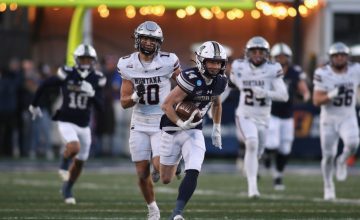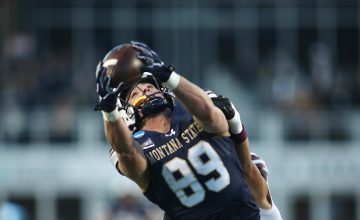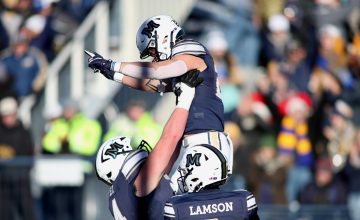Every Big Sky team has played everybody else at least once, so that means it’s time to pick mid-season awards and all-conference teams! Why are we doing this? Well, because we like to give you sweet content, for one, and also it’s a handy way to check back in on every team at the halfway point, and gather scattered thoughts about the league from the first half in one place. A couple notes before we begin:
– A lot of thought went into this, but it’s for fun, meant to spark discussion rather than provoke argument. It’s also just my opinion. Reasonable people can disagree. Several of the choices are agonizingly close. I’ve tried to make clear below which ones those are. Eventually, you have to put somebody on the first team and somebody on the second, or off altogether. That doesn’t mean I think those players are bad. Please don’t take this too seriously.
– I’m using the preseason ballot format for all-conference – that is, one league MVP, who also goes on the all-conference first team along with five other players. Then five on the second team, giving us 11 all-conference players altogether. I’m also not using strict positional requirements for the teams – if you could throw them on the floor together and it doesn’t look ridiculous, that’s good enough for me. I’ll also give my top three for MVP, Freshman of the Year and Newcomer of the Year. I’m not doing Defensive Player of the Year because, frankly, I don’t think I’m qualified to make that pick without watching a lot more Big Sky basketball than the already appalling amount I’m currently watching.
– It’s not difficult to pick up on my innate biases if you read the piece, but I’ll list a couple here, including my primary one: in basketball, team success matters a lot when picking all-conference, because it shows that a player can have an impact on winning, which after all is the point. Obviously there are plenty of other considerations – the rest of the roster, the coach, etc. – but generally speaking it’s difficult for me to consider a player on a bad team one of the five best players in the conference. At the same time, I’d need a good reason to say that the best team in the conference doesn’t have a player worthy of first-team consideration. I also like players who contribute in multiple areas of the game, not just scoring.
Here we go!
MVP
1. Dillon Jones, Weber State
2. RaeQuan Battle, Montana State
3. Steele Venters, Eastern Washington
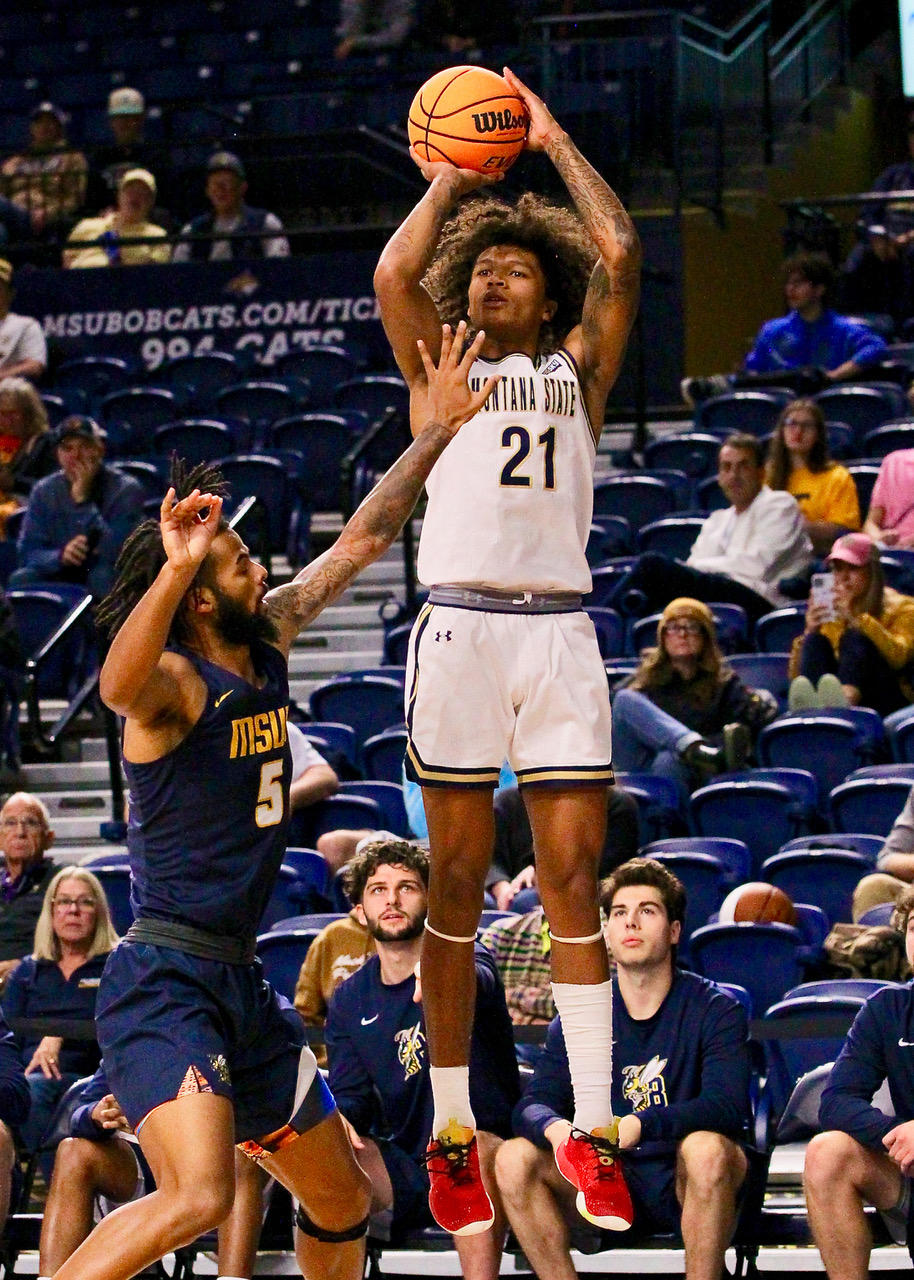
Venters barely sneaks ahead of his teammate Angelo Allegri and a host of other contenders for the third spot, but this is a two-man race – and a razor-thin one. Battle is averaging 17.1 points per game, Jones 15.5, both solidly in the top 10 in the league. Both play for good teams. Both are unique, one-of-one players with one outlier skill – Battle’s athleticism and Jones’ rebounding. I flip-flopped on who to put first multiple times – including at least once while writing the damn thing.
In full flight – when he is taking over games – Battle is breathtaking. Ask Montana (18 points on a variety of seemingly impossible hanging finishes) or Southern Utah (29 points in the non-conference, including the game-winning pull-up with under a minute to go) or, most recently, Sacramento State (a new career-high 32 on 18 shots last weekend). He is capable of doing things that no one else in the conference can. The only possible reaction after some of his highlight plays is staring straight ahead in disbelief.
He also serves as the heartbeat of a Montana State team that, absent an inexplicable loss to Idaho, has steadied itself and re-emerged as one of the top two teams in the league, on the same level as the NCAA Tournament squad from a year ago. Second-level stats say that the Bobcats are the straight-up best team in the Big Sky, with a fatter point differential than Eastern Washington both in and out of conference.
Battle is not flawless. He floats through games sometimes, although my hunch says that’s partially an unfair visual evaluation biased by his cooler-than-cool demeanor. His numbers don’t pop the way you would expect from a 6-5 wing who can jump out of the building, and he struggles to impact the game when he’s not scoring. He’s averaging just 3.1 rebounds and one assist per game, and is third on his own team in both steals and blocks.
He too often defaults to pull-up jumpers, a look he can get every time down the court because, as Travis DeCuire explained after the rivalry game, “we don’t have guys who can jump that high.” He’s shooting 47.1% from the field and just 32.4% from 3 on immense volume – nearly twice as many shots as anyone else on Montana State. The best version of the Bobcats probably takes some of those shots and re-allocates them to Jubrile Belo, Great Osobor or even Darius Brown II.
It’s unfair to measure Battle against what he could be – the possibilities we imagine while watching him. He has one of the highest ceilings I’ve ever seen, and dinging him for not reaching it is an unavoidable instinct. It also regrettably obscures what he is – a singular viewing experience, a jaw-droppingly explosive, liquid-smooth athlete and the alpha for a top-tier title contender.
The surface-level case for Jones rests disproportionately on his rebounding numbers. He’s averaging 10.9 boards per game – not only first in the conference by a wide margin, but fifth in the country behind Oscar Tshiebwe, Zach Edey, Joel Soriano and Armando Bacot. Advanced stats say it’s not a mirage caused by inflated minutes or lightning-quick pace.
Part of me says it’s an overrated narrative. How many of those rebounds are contested and wouldn’t be grabbed by another player in the same situation? How much of it is a result of team strategy and other players deferring to Jones, consciously or not? Weber’s 6-11 British big man Alex Tew is averaging just 3.7 rebounds, and nobody else is above three. Jones isn’t giving the Wildcats more opportunities on the offensive glass, where they’re most valuable – he’s averaging under one offensive rebound per game. From a team-wide perspective, his individual dominance hasn’t made Weber State unstoppable on the glass – the Wildcats are in the middle of the conference in rebounding margin, and dead last in offensive rebounds.
Even so, it’s hard to deny Jones’ motor and nose for the ball – developed, he said, by rebounding for his older brother, who’s now playing professionally overseas. That enhances the rest of his game on defense, where he’s tied for third in the conference with 1.5 steals per game. He can switch across every position. He relishes competing on the big stage and in big games. The entire second half of Weber’s game in Missoula was a montage of him flexing and screaming at the ceiling of Dahlberg Arena after big plays.
Jones is hitting 36.5% of his 3-pointers, and 44.8% in conference play – huge numbers for one of the most devastating slashers in the league, and a developing story to watch. His playmaking is coming along – fourth in the league in assists, although with a nearly even assist/turnover ratio, slinging passes off the dribble to shooters with either hand. With Weber State’s roster build this year, he’s been their only consistent shot creator.
So much of the comparison between the two is colored by the teams around them. Jones is doing more with less. Battle plays with an all-conference caliber big man and point guard on the floor with him at almost all times, which influences the rebounding and assist numbers I criticized above. The ‘Cats don’t need that from him.
There is not an easy answer. Think about it long enough, and you end up chasing down statistical rabbit holes and twisting yourself into loops. The second half of the season might provide a clearer answer. The conference tournament certainly will. In the end, this is where I ended up – Jones’ all-the-time, both-ends impact, by the slimmest of margins, over Battle’s awe-inspiring, sky-walking majesty.
ALL-CONFERENCE FIRST TEAM
RaeQuan Battle, Montana State
Dillon Jones, Weber State
Steele Venters, Eastern Washington
Jubrile Belo, Montana State
Angelo Allegri, Eastern Washington
Josh Bannan, Montana
Belo and Allegri make it on their own merits – not because of some rigid requirement to reward what are clearly the two best teams in the league.
A fully engaged, motivated Belo is still an unmatched force of nature. His averages are distorted because the Bobcats have a quality backup big in Great Osobor, allowing Danny Sprinkle to manage Belo’s minutes. He’s played less than anyone else in the top 25 in the league in scoring other than Idaho State’s lumberjack post Brayden Parker.

On a per-minute basis, Belo’s numbers compare to Battle, Jones or Venters. He’s averaging 22.6 points per 40 minutes. The league’s leading scorer, Northern Colorado’s Dalton Knecht, is at 23.0.
Does it matter that Knecht has played 757 minutes – the second-most in the league behind Idaho’s Divant’e Moffitt, and 250 more than Belo? Yes, and that’s a point in the Northern Colorado sniper’s favor. But Belo has not been injured (except for a weird laceration on his hand last weekend). He’s not getting played off the floor, or being forced to sit because of foul trouble. He’s been available. Do you punish him because Osobor is good enough to absorb those minutes, or because the ‘Cats are good enough to build up big leads – leads Belo often has a hand in creating in the first place?
Sprinkle still unleashes Belo in important or close games, and he’s responded – 17 and 12 in 33 minutes against Weber State two weeks ago, 15 and 11 in 30 minutes in an upset loss to Idaho two days later. That trend should continue as the season winds down and the games start having real consequences, which would nudge Belo’s averages up closer to where they were last year – when he was the deserved conference MVP.
Allegri has played a ton of minutes, and he’s averaging 13 points per game – just 16th in the league, one spot ahead of Belo. Eastern Washington is not as good as their undefeated conference record indicates – their point differential isn’t as good as Montana State’s and they’ve only won three out of 10 conference games by double digits. Reasonable people can look at those numbers and argue for Bannan, or Knecht, or Idaho’s Isaac Jones, over Allegri. The margins are thin.
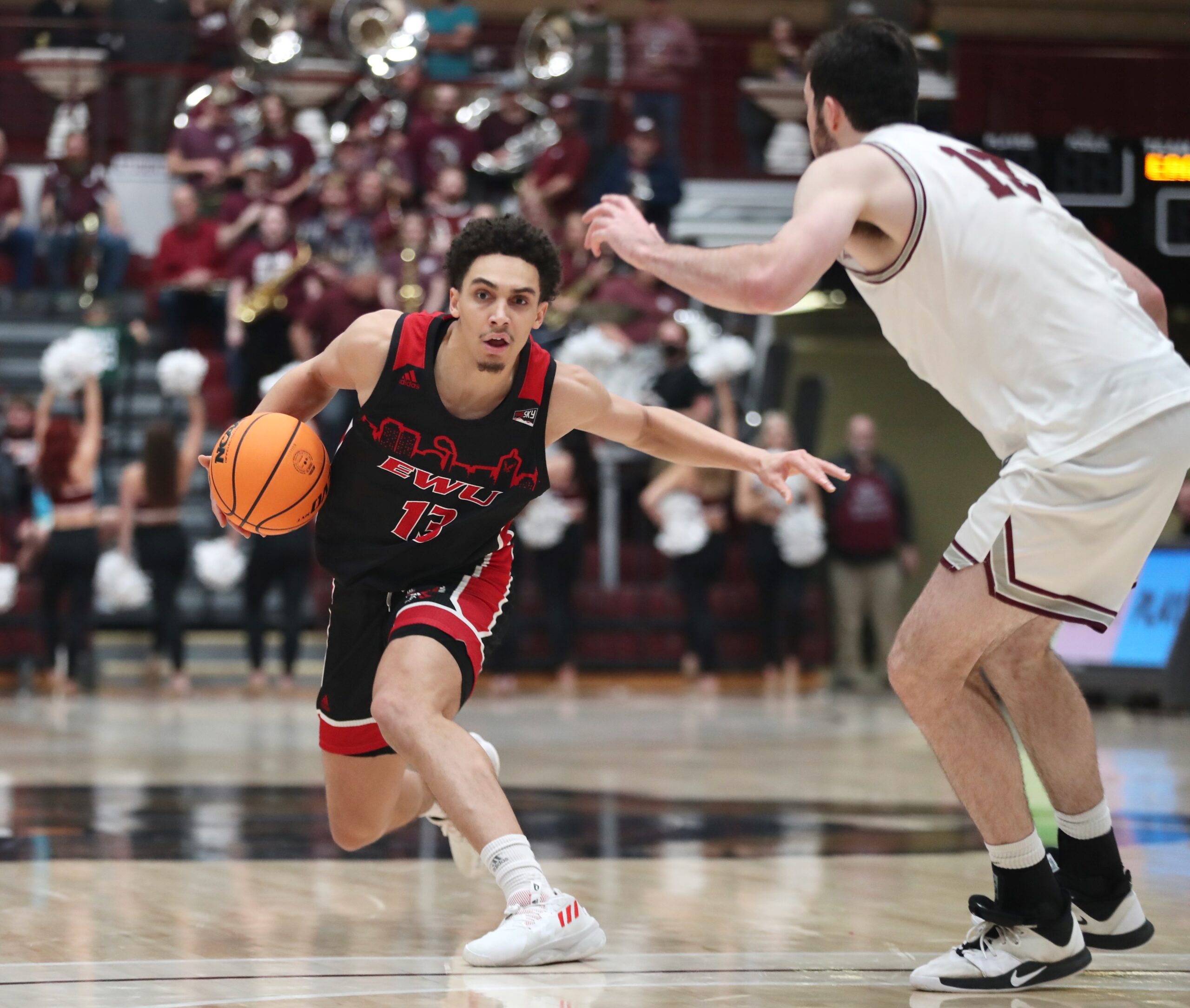
But the fifth-year guard, originally from UNC-Greensboro, is one of the biggest eye test players in the league. He’s never rattled and he plays with swagger. He plays his best against good teams – he had 19 at both Montana and Montana State early in the conference schedule, and 28 in Eastern’s most recent game against Weber State, including a ridiculous leaning 3 late to all but ice it.
At 6-foot-7, he (along with the 6-foot-7 Venters) unlocks the Eagles’ superpower, letting them go big and mash teams on the boards without losing any skill or shooting. Allegri is averaging 5.6 rebounds per game, second on the team (and barely so – Casey Jones is at 6.0) for the team with by far the best rebounding margin in the conference.
He’s shooting 36% from 3 and averaging 3.4 assists, which is top-10 in the league. He does a lot of things just well enough – shooting, creating, rebounding – to make him immensely valuable for the team with the best record in the league. To me, that puts him – narrowly – ahead of Bannan or Knecht.
Montana’s recent swoon knocks Bannan down into the large group of “good stats, mediocre (or just bad) team” candidates fighting for the last spot, one that also includes *deep breath* Northern Colorado’s Knecht and Daylen Kountz, Idaho’s Isaac Jones and Divant’e Moffitt, Northern Arizona’s Jalen Cone, Sac State’s Zach Chappell and Portland State’s Cameron Parker.
Knecht might have the best case out of all of them – 20.8 points and 7.3 rebounds on 48/40/79 shooting percentages, taking 6.6 3s per game and making 2.7 with a ridiculous 24.7 points per game in conference play. How much responsibility does he bear (get it?) for Northern Colorado’s long, depressing slide from 13-7 in league games last year to 2-7 so far this year? Steve Smiley brought back his two leading scorers, Kountz and Matt Johnson, alongside Knecht, and they’re still struggling.
Most of that is not Knecht’s fault – Kountz and Johnson have taken huge steps back. Smiley has been unable to find a workable defense without Bodie Hume, who graduated, or rim protector Kur Jongkuch, who transferred to Temple. The Bears are not a mediocre team hamstrung by bad luck – their season-long point differential is the worst in the league, more than double that of ninth-place Northern Arizona. Their conference-only point differential puts them solidly in the trio of cellar-dwellers alongside the Lumberjacks and Idaho. Every argument for Knecht as a top-six player in the league runs into the same intractable counter: then why is his team so bad?
Despite the entire rest of the Hornets’ roster being new, hyped transfers, Chappell remains the heartbeat for Sac State. The Hornets are a sneaky contender, at 5-4 with a blowout win over Montana and razor-thin losses to Eastern Washington and Weber State. They might be the fourth-best team in the league – or even the third if Weber stumbles. Hulking teammate Callum McRae is at 12 points and 9.4 rebounds per game, but that feels about par for someone listed at 7-1, 280 in the Big Sky.
Isaac Jones (19.1) and Moffitt (18.6), the second- and third-highest scorers in the league, have combined to give Idaho the best offensive numbers (although they only have the fourth-highest in conference play – the Vandals’ numbers were boosted by a tissue-soft non-conference schedule). Jones is one of the best athletes in the league and looks unstoppable at times, shooting 66% from the field and grabbing 7.5 rebounds. How would he look with at least one competent outside shooter spacing the floor around him? He ran through Montana for 25 points and then Sac State for 42 in back-to-back games earlier in the season, but has a combined 10 points in the Vandals’ two games against Montana State’s league-best front-court.
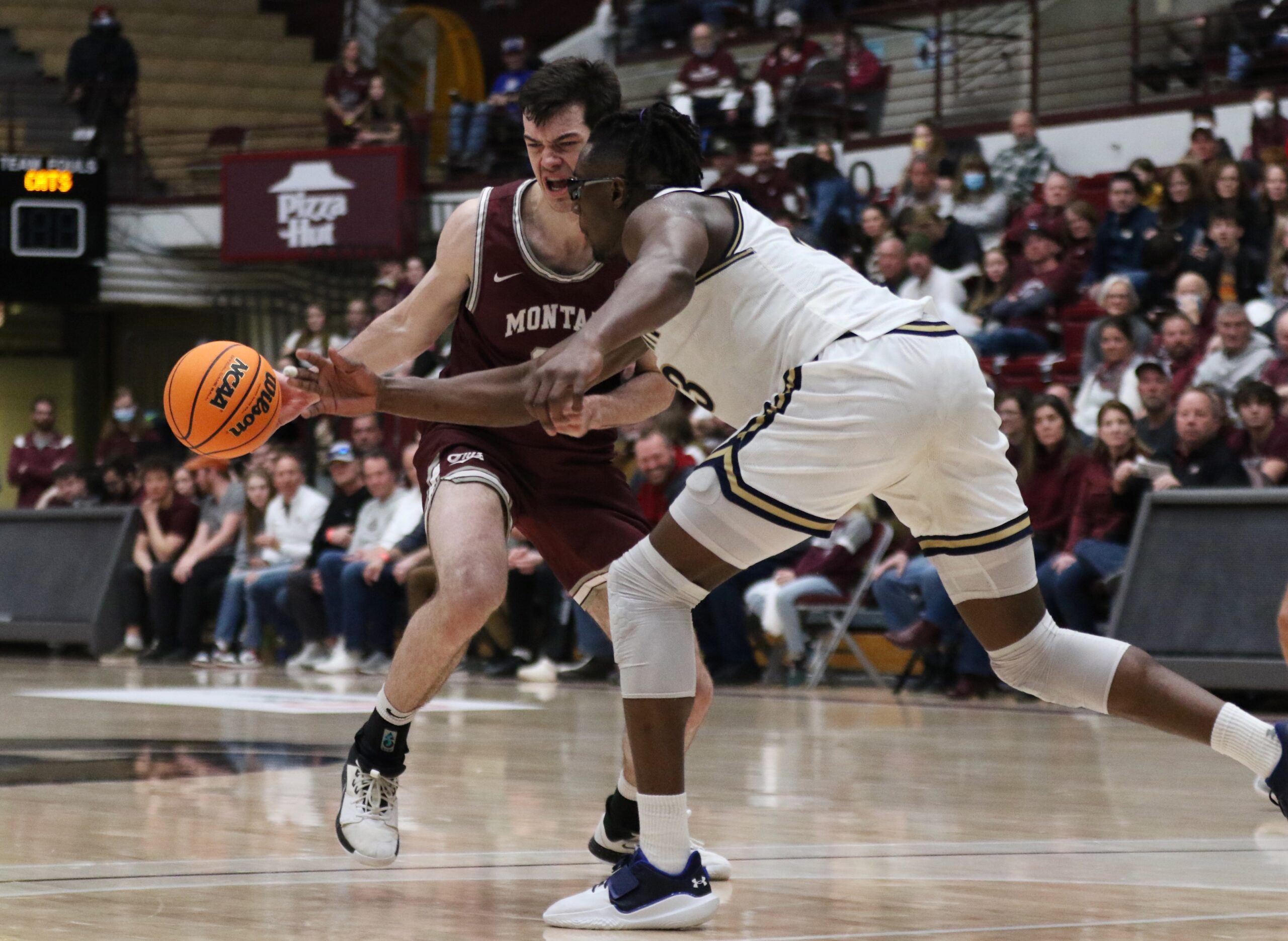
Parker, going from Montana to Portland State for his final season, remains the Platonic point guard, leading the league with 5.9 assists per game – always looking for hit-ahead passes in transition and slicing into the lane not to create simple kickout passes to shooters, but dropoffs for dunks at the rim. He’s also boosted his scoring average from 9.1 to 15.5, is hitting 39% from 3 and, at just 6-2, gets to the line more than anyone else in the league. He’s a real first-team contender, and the frontrunner for two non-existent awards, Most Improved Player and the Oltrogge/Marxen Award for best in-conference transfer.
Despite not playing on a bad team, Montana State’s Darius Brown II infiltrates this group as a player who should receive serious all-conference consideration, leading the league in assist/turnover ratio and hitting huge shots down the stretch of the Bobcats’ rivalry win at Montana. He’s just good.
But Bannan has been everything for a Montana team that’s still hanging around the fringes of real contention – leading the Grizzlies in scoring (15.4, narrowly over Aanen Moody) and both scoring and assists by jawdropping margins. Nobody else on the team is averaging over five rebounds per game (Bannan’s at 8.5). Despite being 6-9, his 80 assists are nearly double the next-closest Griz (Brandon Whitney has 44).
Despite a…less than aesthetic left-handed stroke, the Aussie is shooting 51/42/78, carrying Montana’s janky offense for long stretches and working hard to keep the Griz above average on the boards, laboriously leaping out of scrums under the basket for rebounds like a great fish trying to escape the net. The Griz put him at point guard – not just on offense, but also guarding Parker – for most of the game Saturday against Portland State, and he had 17 points, 11 rebounds and six assists in a must-win victory to stop Montana’s three-game skid.
Montana is not Northern Colorado or Idaho-level bad. The Griz – narrowly – have a positive point differential overall, and a solidly positive margin in conference play. Aside from a blowout loss at Sac State, they’ve been in contention in every one of their six conference losses – a miracle steal and buzzer-beater by Weber State away from being 5-5 with a win over one of the conference’s top three teams. If Venters and Allegri, in your mind, get a bonus for Eastern’s record in close games, it’s probably fair to demerit Bannan for Montana’s abysmal record in the same. This analysis says that’s not enough to keep him off the first team.
The players fighting for that final spot are a high-quality, tightly-bunched group with plenty of thorny dilemmas to puzzle out. How do you measure Knecht and Isaac Jones’s stat lines against Bannan’s slightly lesser contributions to a better team – or Brown’s to an even better one? What about Parker’s passing – the biggest outlier individual skill in the group – to Bannan and Knecht’s all-around games? There are no easy answers.
Second team: Knecht, Parker, Brown II, Chappell, I. Jones
NEWCOMER OF THE YEAR
1. Isaac Jones, Idaho
2. Darius Brown II, Montana State
3. Aanen Moody, Montana
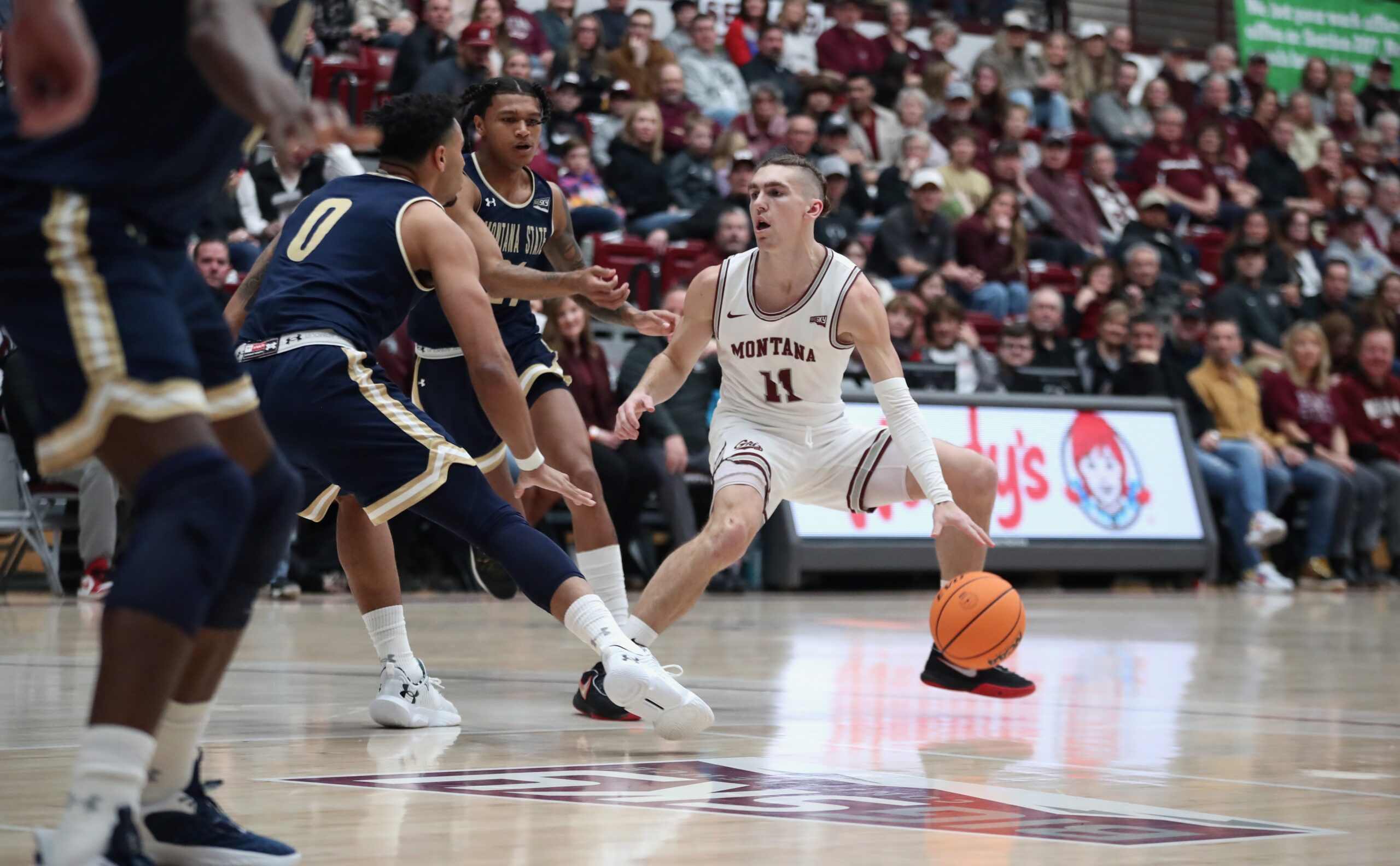
The top two are covered above. I’m not counting Parker as eligible, but I am including Moody, the former Southern Utah sharpshooter, mainly because I wrote about Parker above and haven’t gotten to Moody yet. The redshirt senior guard revs up Montana’s offense by zooming off curls from the corner to take handoffs at the top of the key, looking to shoot as soon as he gets it or pitching the ball back to Bannan if the defense gets lost on a switch. He’s averaging 14.2 points per game, 12th in the league, shooting 38.4% from 3-point range on over six attempts a game – important volume for a Griz offense that needs as much spacing as it can get around Bannan and Brandon Whitney. If Parker was eligible, he’d be second, with everybody else sliding down a spot.
FRESHMAN OF THE YEAR
1. Nigel Burris, Idaho
2. Caleb Shaw, Northern Colorado
3. Maleek Arrington, Idaho State
In a race without any standout candidates, Burris takes it on the back of 8.6 points and 5.2 rebounds per game, both league-highs among freshmen. Like Burris, most of the freshmen playing in the league are on bad teams as they try to build their future – Daniel Rouzan, who’s averaging 3.8 points on good shooting percentages in 10 minutes a game for Weber State, is the closest a freshman has come to contributing to a contender.

Shaw is averaging 6.2 points per game for Northern Colorado, which is also getting minutes from Brock Wisne. Arrington is at 4.7 points and good defense as a constant off the bench for Idaho State.


